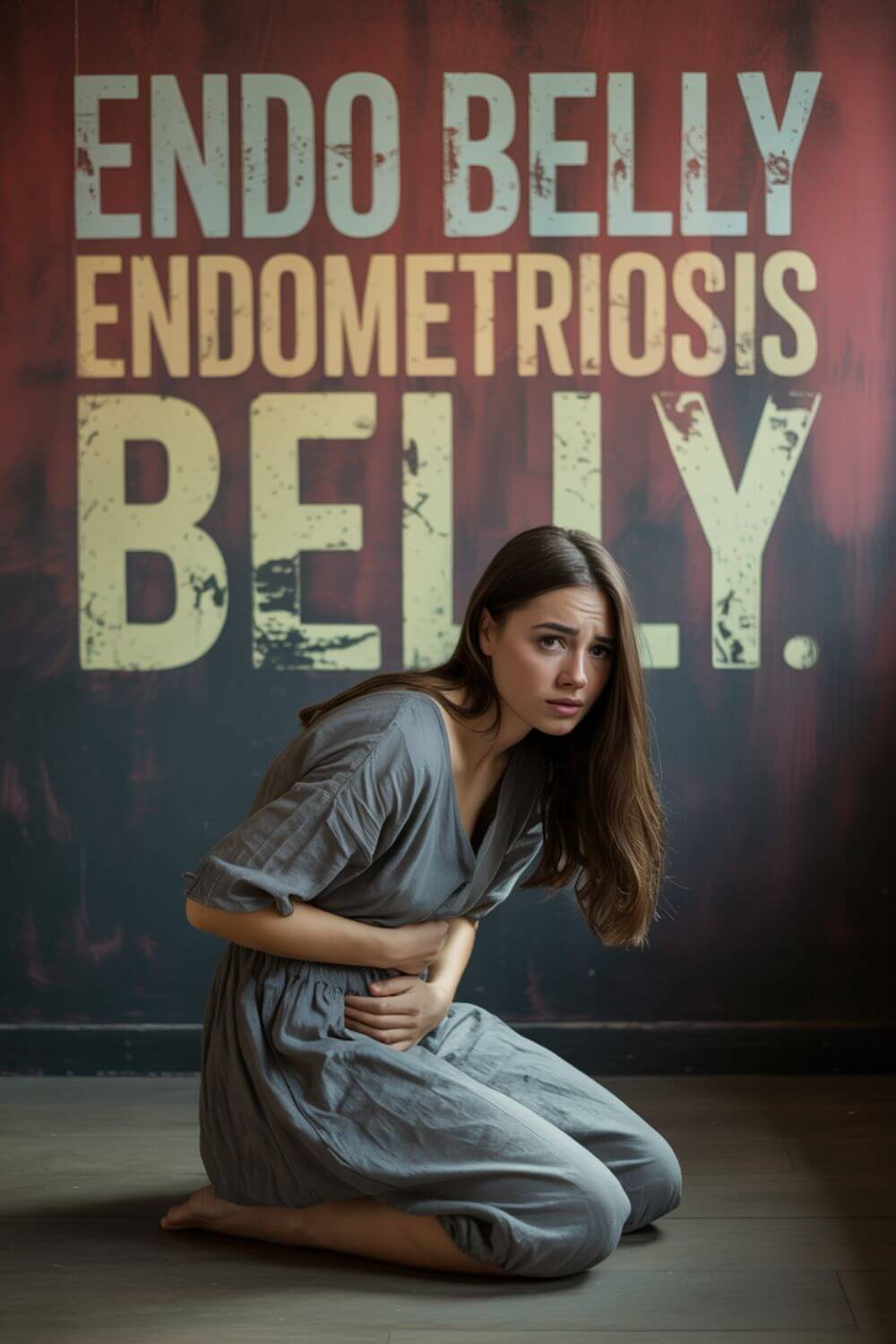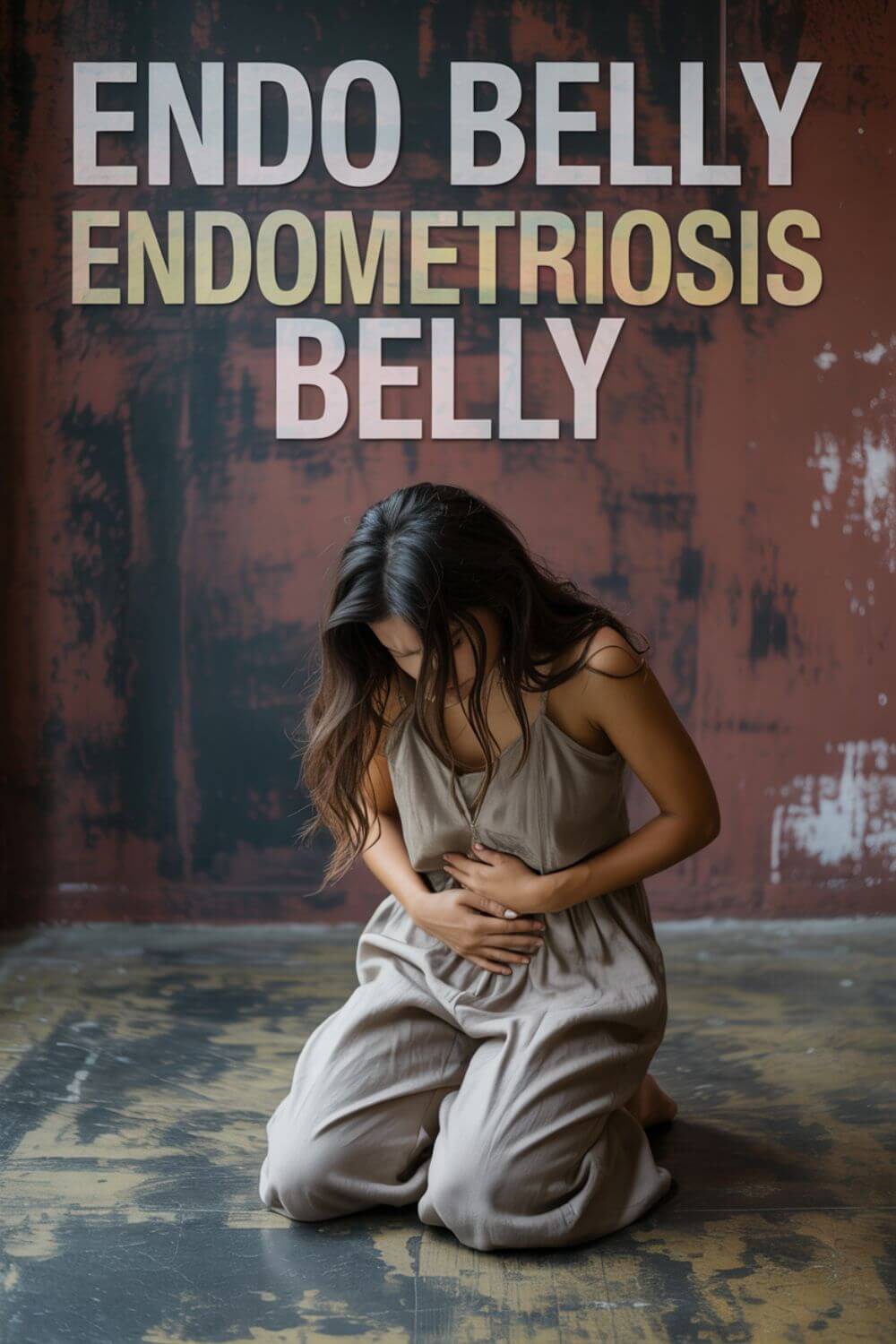Endo Belly – Endometriosis Belly
Have you ever looked in the mirror and wondered why your stomach suddenly looks swollen, tight, or even pregnant… only to feel like nobody understands the pain or what’s really going on? Could it be endo belly – and what does that even mean when your whole life feels hijacked by your own body?
Endo belly is a painful, distressing symptom of endometriosis that causes intense abdominal bloating, visible swelling, and discomfort—physically, emotionally, and mentally. It can appear out of nowhere, ruin your day, and make you feel trapped inside a body that doesn’t feel like your own.
I remember the first time my wife clutched her stomach, tears welling up in her eyes—not because of hunger or overeating, but because her body felt like it was punishing her for something she didn’t do. Her belly was so swollen that it looked like she was six months pregnant. And all she could say through gritted teeth was, “I don’t even know what I did wrong…”
This article will take you deep into the world of endo belly—not just with facts and symptoms, but with real emotions, real stories, and the painful reality women live with every day.
- Understanding Endo Belly Through My Wife’s Eyes
- Endo Belly vs Other Bloating
- Endo Belly Symptoms and Signs
- What Causes Endo Belly?
- What Endo Belly Looks Like?
- How Long Endo Belly Lasts?
- Endo Belly After Surgery
- Endo Belly and Your Cycle
- How to Relieve Endo Belly?
- Endo Belly Daily Management Tips
- Endo Belly with Other Conditions
- Endo Belly Body Image Impact
- When Endo Belly Is Serious?
- Living With Endo Belly – A Husband’s Perspective
- Final Word on Endo Belly
Understanding Endo Belly Through My Wife’s Eyes
Endo belly is more than just bloating. It’s a sudden, painful, often terrifying transformation that can take a woman from feeling fine to completely undone in a matter of hours. And unless you’ve lived with someone who battles it, like I do with my wife, it’s hard to truly grasp how deeply it can wound—not just the body, but the spirit too.
I’ve seen her change outfits three or four times in a single morning—not because she’s picky, but because nothing fits. Nothing feels right. Her jeans won’t close. Her dress won’t fall the way it used to. That once-flat stomach is now hard, stretched, and achingly sensitive to the touch.
And yet, there are no warnings. No signs. Just… boom. It arrives, steals the day, and leaves her curled up, asking me if she’s broken.
This isn’t just about physical pain. It’s about identity. About feeling like your body has turned on you. That’s what endo belly does—it inflates more than your gut; it inflates your fears, your shame, your sense of not belonging in your own skin.
When I first started blogging, I didn’t imagine I’d be writing about things like this. But then I watched my wife cry after someone asked her when the baby was due. She wasn’t pregnant. She was in agony. And I knew in that moment: more people need to hear about what endo belly really is.
I started learning every trigger, every symptom, and every pattern—because I wanted to do something, anything, to make her feel safer. More understood. More in control. Even if that just meant giving her a different pair of leggings when everything else hurt.
I built a work-from-home life not because it sounded cool, but because it gave her the space to rest when flare-ups hit. It gave me the freedom to stand by her side when her belly flared so badly, she couldn’t breathe properly sitting up straight. It’s changed the way we both live.
And because I’ve walked beside her through this, I want you to understand how many layers this thing has. It’s not just about swelling.
it’s about:
- how endo belly vs other bloating feels completely different to someone who lives with endometriosis
- the symptoms and signs that signal it’s not “just gas” or “something you ate”
- what causes endo belly to appear in the first place
- what it looks like on the outside (and why that matters more than people think)
- how long it lasts—and why it never seems to be consistent
- why it often flares up after surgery or hormonal shifts
- how it connects with your menstrual cycle in ways few people realize
- what helps relieve it, both in the moment and long-term
- daily management tips that might give your partner or yourself a little peace
- how other conditions overlap and complicate it
- what it does to body image when you don’t feel like yourself anymore
- and when it’s serious enough to seek help
In the next part, I’ll dive into how endo belly compares to other types of bloating—and why it’s nothing like the kind you get from a big meal or a fizzy drink.

Endo Belly vs Other Bloating
You might think bloating is just bloating. But endo belly? It’s in a league of its own.
When my wife tells me her stomach hurts, I don’t ask, “What did you eat?” anymore. That’s what I used to say—before I understood. Before I saw the difference with my own eyes. Before I learned the truth about endo belly vs other bloating.
Typical bloating might make you feel uncomfortable, sure. You might feel gassy or a little puffed up after a big meal or during your period. But it usually passes, right?
Endo belly doesn’t.
It distorts her entire abdomen. Her stomach balloons out within hours, sometimes minutes. It’s firm to the touch, hot, and painful—not the soft, air-filled bloat most people know. It’s not food-related. It’s not about digestion. It’s inflammation—deep, persistent, hormonal, and linked to something far more complex: endometriosis.
I’ve watched her lie in bed with her hands gripping her midsection, begging for it to calm down. Not just because it hurts, but because of what it means—that her endometriosis is flaring again. That something is wrong inside. That the condition is reminding her it’s still there, still in control, still playing its cruel game.
And there’s the emotional toll, too. Bloating from food might be annoying. Endo belly is humiliating. It steals her confidence. She won’t go out. She won’t let me take pictures. Sometimes, she won’t even eat—not because she’s not hungry, but because she’s terrified anything will make the swelling worse.
Other bloating responds to a warm tea, a walk, or a bit of time. Endo belly doesn’t always listen. Sometimes, we do everything right—heat pads, herbal teas, soft clothes, rest—and it still holds on for days.
And maybe the cruelest difference? People believe you when you say you’re bloated from food. But when you say it’s endo belly, they stare blankly. They don’t know what it is. Some even think you’re exaggerating. That disbelief is another wound layered onto an already unbearable experience.
Next, I’ll walk you through the actual signs and symptoms of endo belly—so you can learn to spot it, support her through it, and stop mistaking it for something it’s not.

Endo Belly Symptoms and Signs
Endo belly doesn’t whisper. It roars—loudly, painfully, and without mercy.
The signs often come fast and leave slowly. One moment, my wife’s getting ready to leave the house; the next, she’s bent over the bed, holding her abdomen like something inside is trying to push its way out. And I stand there, helpless, watching the symptoms hijack her day yet again.
It usually starts with that visible swelling—her belly pushing out, high and tight, almost like she’s in her second trimester. But it’s not just appearance. It’s pressure. It’s cramping. It’s heat radiating from her lower stomach. Sometimes she winces just from the touch of her own leggings.
Then come the waves of nausea. The fatigue that drains her even though she hasn’t done anything. Her body starts sending conflicting signals—she’s hungry but can’t eat, she’s tired but can’t sleep, she’s in pain but too bloated for painkillers to settle properly.
The symptoms of endo belly go far beyond just bloating. My wife often experiences sharp, stabbing sensations that shoot through her lower abdomen. Sometimes she feels like she can’t sit upright without feeling like her insides are tearing.
Constipation kicks in too, especially when the swelling is severe. Or the opposite—sudden, urgent bowel movements that leave her doubled over and exhausted. It varies. That’s the cruel part. There’s no consistent rhythm, no reliable signpost to prepare for what’s coming.
She gets flushed. Her skin becomes sensitive. She tells me her whole core feels “inflamed.” And sometimes, there’s shortness of breath—yes, even that—because the swollen belly presses against her diaphragm.
But do you know what’s worse than the physical signs?
The look in her eyes when she says, “I hate how I look right now.” When she tries to hide from me, ashamed of something that isn’t her fault. When she doesn’t feel like herself—not just in her body, but in her spirit.
These are the real symptoms of endo belly. The ones no medical pamphlet ever really prepares you for. And if your partner is going through this, what she needs isn’t just your understanding—it’s your patience, your presence, and your voice reminding her that she’s still beautiful, still worthy, still her.
Now let’s explore what actually causes this cruel swelling in the first place—because the more you understand, the better you can fight back together.

What Causes Endo Belly?
If you’ve never lived with someone who has endometriosis, it’s easy to assume bloating like this must be food-related or maybe even hormonal “PMS stuff.” I used to think that too—until I watched my wife suffer through wave after wave of unexplained swelling that had absolutely nothing to do with what she ate.
The truth is, endo belly is caused by a perfect storm happening inside the body—where inflammation, hormonal chaos, and sometimes even scar tissue come together like a violent orchestra that plays in her abdomen.
One of the biggest culprits is inflammation. Endometriosis causes tissue similar to the uterine lining to grow where it doesn’t belong—on the ovaries, bowels, bladder, and other organs. These growths respond to hormonal changes just like the uterus does, except they have nowhere to go. So the body reacts. It swells. It gets angry. And her belly inflates as a result.
This isn’t simple water retention. It’s systemic inflammation. Her immune system is constantly on high alert, trying to “attack” the misplaced tissue. And that triggers bloating from deep within—not just in her gut, but around it.
Then there’s the hormonal side. Estrogen dominance, common in endometriosis, can mess with gut motility and cause food sensitivities. I’ve watched my wife react to meals she used to love, her belly expanding painfully just minutes later. It’s like her body keeps rewriting the rules on her without warning.
And let’s not forget the digestive issues that tag along. Endo often comes with irritable bowel symptoms. Trapped gas, slow digestion, constipation—all of these can worsen the swelling. But again, they’re not the root. They’re just part of the cascade of effects endometriosis sets off.
What makes it worse? Stress. Lack of sleep. Her monthly cycle. Even recovering from surgery. All these factors can amplify the underlying inflammation and hormonal chaos, making the bloating more severe and more frequent.
Sometimes, she’ll have done everything right—eaten clean, rested, taken her supplements—and still, the belly comes. That unpredictability? It’s soul-crushing. And that’s what causes the emotional side of endo belly to grow as much as the physical.
Next, I want to show you what endo belly actually looks like—not just in theory, but how it shows up in real life, in bodies, in emotions, and in moments that change everything.

What Endo Belly Looks Like?
It’s not an exaggeration when women with endometriosis say their belly looks pregnant. I’ve seen it—really seen it. One moment, my wife’s stomach is flat. The next, it’s rounded, stretched, and swollen like she’s in her second or even third trimester. And yet, there’s no baby. Only pain.
What makes endo belly so different from the usual bloat is how visible and distorted it becomes. It’s not just a little puffiness—it’s a full expansion. Her lower abdomen becomes tight, hard, and sometimes shiny from the pressure building underneath. It can rise so high that her ribs feel compressed, and she struggles to sit comfortably.
When we’re home, she immediately changes into loose clothing. Her hands instinctively go to her stomach, not to caress it, but to hold it—as if bracing herself for a storm. Sometimes she looks at herself in the mirror and says, “I don’t even recognize this body.” And that’s the part people don’t talk enough about: how endo belly steals your reflection.
She won’t take selfies. She avoids mirrors. She turns down video calls. Not because she’s vain—but because endo belly changes how she sees herself. It makes her feel foreign in her own skin.
It doesn’t matter how beautiful I tell her she is. She can’t feel it in those moments. All she feels is invaded. And it breaks my heart every time.
And the worst part? It can happen at any time. We’ve had to cancel plans, miss weddings, and leave restaurants early because the swelling became so severe she could barely stand.
I once watched her lie on the bathroom floor, curled up in a ball, tears streaking her cheeks, whispering, “It’s not even my period… why is this happening now?” That’s what endo belly looks like—it looks like grief, fear, pain, and powerlessness, all rolled into one symptom no one warned her about.
For many women, endo belly isn’t just a physical change—it’s a constant reminder that their body doesn’t feel like theirs anymore.
In the next section, I’ll share how long endo belly typically lasts—and why that unpredictability can turn even the best day into one of the hardest.

How Long Endo Belly Lasts?
One of the hardest parts about endo belly is not knowing how long it’s going to stick around. There’s no timer. No warning. No promise that if you just wait a little longer, it’ll go away. For my wife, it’s like being taken hostage by her own body—sometimes for hours, sometimes for days.
I’ve seen it disappear overnight after a warm bath and rest… and I’ve seen it linger for three days straight, growing tighter and heavier with each passing hour. Sometimes it’s gone in the morning, and sometimes it waits until 3 a.m. to show up like an uninvited guest that ruins everything.
There’s no pattern. No calendar. No rules. It can flare up mid-cycle, during ovulation, right before her period, or even after it ends. Some women say it only lasts a few hours. For others, like my wife, it can last all weekend and make her miss out on everything she was looking forward to.
We once had a beach trip planned. She was so excited. Her favorite bikini, a new book, sun on her skin. But then—on the very morning we were supposed to go—her stomach blew up. Tight as a drum. She couldn’t move without pain. She didn’t just cancel the trip. She cried the entire day.
That’s the emotional weight of endo belly. It’s not just the pain—it’s the plans it steals. The memories it takes. The way it shows up just when you finally feel a little free.
And the worst part? There’s nothing to guarantee when it’ll ease. Heat packs, herbal teas, fasting, soft clothing—sometimes they help. Sometimes they don’t. There’s no consistency. And that uncertainty is its own kind of suffering.
My wife often says, “I could deal with it better if I just knew when it would stop.” But she doesn’t. And neither do I. All I can do is stay near, hold her hand, and remind her: this too will pass—even if we don’t know when.
Next, we’ll talk about how endo belly shows up after surgery—because healing from one thing often means waking up to another.

Endo Belly After Surgery
You’d think that surgery would bring relief—that after going under the knife to remove endometriosis lesions, the pain would finally ease. But for many women, including my wife, endo belly doesn’t just stick around—it sometimes gets even worse right after surgery.
I still remember the day she came home from her laparoscopy. Her body was sore, stitched, fragile. We both had hope. Maybe this time, things would change. Maybe the worst was behind us. But within hours, her stomach began to swell—tight, hot, stretched out just like before. Except now, it was mixed with the trauma of fresh wounds and post-op exhaustion.
The truth is, after surgery, the body goes into a protective state. There’s inflammation from the incisions, fluid retention from the IVs, and trapped gas from the CO₂ they pump into the abdomen to see better during the procedure. That gas doesn’t just disappear—it lingers, pushing against already irritated organs. And for someone with endometriosis, whose body is already inflamed, this creates a perfect storm.
But here’s the thing no one prepared us for: the emotional crash.
My wife felt betrayed by her body again. She had put herself through surgery. She endured the fear, the risk, the recovery. And still—there it was. The same ballooned stomach. The same pain. The same discomfort in clothes. She whispered, “Why do I still look pregnant when I just had surgery to feel better?”
Post-surgical endo belly can last for weeks. Even when the external scars are healing, the internal trauma still causes bloating, cramping, and inflammation. And emotionally, it can undo all the hope the surgery was meant to bring.
We learned to prepare for this. Soft clothes only. No expectations. Gentle foods. A calm environment. But no matter how much we planned, it still stung every time it came back. The disappointment cuts deep when healing doesn’t feel like healing.
In the next section, I’ll take you into the rhythm of endo belly and your cycle—and how it seems to dance to the beat of her hormones whether she likes it or not.

Endo Belly and Your Cycle
There’s a rhythm to it—one I started to see before my wife even noticed. Endo belly doesn’t just show up randomly. It follows her cycle like a shadow, creeping in before her period, around ovulation, and sometimes lingering long after the bleeding stops. It’s like her hormones are setting off a silent alarm her body can’t shut down.
In the days leading up to her period, I can feel her tension build—not just emotionally, but physically. Her belly starts to swell. Her mood dips. Her energy crashes. It’s as if her body already knows what’s coming before her calendar does. That premenstrual bloat? It’s not normal. It’s a war zone inside her body.
Ovulation doesn’t spare her either. Right around the middle of her cycle, she often feels sharp pelvic pain followed by that familiar expansion in her belly. We used to think it was just hormonal. Now we know—it’s inflammation triggered by endometriosis reacting to hormonal shifts like a ticking time bomb.
But what really messes with her is the unpredictability. Some cycles, endo belly shows up like clockwork. Others, it skips a beat and hits her after her period has ended—just when she’s starting to feel like herself again. That uncertainty makes it hard to plan anything. No two months are ever the same.
Birth control helped manage it for a while—but not completely. When she tried coming off it to let her body rest from the side effects, the symptoms exploded. Her belly would swell twice a month instead of once. Every hormonal shift felt like a trigger.
And even though she tracks her cycle religiously, it doesn’t give her control. Only warnings. And sometimes, not even that.
Living around her cycle means living around pain. Around swelling. Around clothing that doesn’t fit. Around anxiety that grows with each cramp and each flare.
Endo belly doesn’t ask for permission. It rides the hormonal waves and crashes down hard—again and again.
In the next section, I’ll share what we’ve learned about how to relieve endo belly—what actually works for her, and what might help your partner too when nothing else seems to.

How to Relieve Endo Belly?
When my wife clutches her stomach in tears, desperate for relief, I’d give anything to take the pain away. I’ve researched, tested, and stood by her side through so many trial-and-error moments trying to figure out how to relieve endo belly. And while nothing cures it completely, some things do help ease the intensity—even if only a little.
Heat is her first line of defense. We’ve gone through more heating pads than I can count. The warmth seems to soften the pain, relax the cramping, and make her feel less constricted. Sometimes she lies still with one across her belly, eyes closed, trying to just breathe through it.
Clothing matters too. She has a drawer full of “flare-up” outfits—loose dresses, soft joggers, oversized tees. The kind that don’t press against her swollen stomach or make her feel even more exposed. We learned early on that tight waistbands are the enemy.
Food plays a role as well. We noticed that cutting down on gluten and processed sugar made a visible difference in how often the swelling occurred. Anti-inflammatory foods like turmeric, leafy greens, and ginger have become staples in our kitchen. It’s not a magic fix—but it helps.
Then there’s movement. Gentle yoga, slow walks, light stretching—anything that keeps her body engaged without overdoing it. On bad days, even walking from bed to couch feels like a marathon. On better days, stretching her lower back and hips provides just enough release to reduce the pressure.
Supplements have also helped—especially magnesium and digestive enzymes. But again, it depends. What works for one woman might not work for another. We’ve learned to listen closely to her body, and not push something just because someone else swears by it.
And perhaps most importantly—stress. The more stress, the worse the swelling. I try to shield her from stress as much as I can. I run errands, handle emails, and give her space when she needs it. Because I’ve seen how cortisol adds fuel to the fire.
Emotional relief is just as important. She needs comfort, validation, touch. Not advice. Not fixes. Just someone to say, “I know this hurts, and you’re not alone.”
Relieving endo belly isn’t about a single solution—it’s a lifestyle, a toolbox, and a daily act of compassion.
Up next, I’ll break down our best daily management tips—small things that make a big difference when you’re living with this every single day.

Endo Belly Daily Management Tips
Living with endo belly isn’t just about reacting when it flares—it’s about managing it every single day, even when things feel okay. Over time, my wife and I have built routines, made sacrifices, and reshaped our entire lifestyle to give her a fighting chance at peace in her body. It’s the little things, done consistently, that make the biggest difference.
The first shift we made was accepting that this wasn’t “just bloating.” Once we stopped treating it like something temporary and started preparing for it like a chronic symptom, everything changed. Her wardrobe, our pantry, our daily rhythms—they all adjusted to support her comfort and stability.
Every morning starts slow. We stopped rushing. She drinks warm water with lemon or ginger—never cold—and skips inflammatory breakfasts like sugary cereals or bread. Instead, she eats small portions of gut-friendly foods, things that soothe rather than trigger.
We plan her meals in advance, spacing them out, so her digestion isn’t overloaded. Smaller, more frequent meals give her body less to fight against. And when she’s not up for food, we don’t push. Her body knows better than any schedule.
Movement is built into the day, but gently. Whether it’s five minutes of stretching after waking up or a walk in the garden, the goal is to keep her body circulating without demanding too much. Stillness helps, but stagnation hurts.
Hydration is another pillar. She drinks herbal teas—peppermint, chamomile, fennel—and avoids fizzy drinks entirely. Anything that creates gas is out. She learned that the hard way after one sip of sparkling water sent her straight to bed.
We also started keeping a symptom journal. Every flare-up gets recorded—what she ate, what part of her cycle she was in, how much stress she was under. Over time, we noticed patterns. That journal has become our roadmap.
And then there’s rest. Real rest. Not just sleeping, but unplugging. Phone off. Mind calm. We dim the lights. Play soft music. I’ll massage her back or simply sit beside her while she breathes through it. Those moments don’t fix everything—but they create space to cope.
None of this is perfect. Endo belly still comes. But these little acts—done daily—give her a sense of control in a body that often takes it away.
Next, I’ll explain how endo belly can be affected by other conditions—and why it’s often misdiagnosed or overlooked entirely because of them.

Endo Belly with Other Conditions
Endo belly doesn’t always show up alone. In fact, one of the most painful things we’ve learned is that it often walks hand-in-hand with other conditions—making it harder to diagnose, harder to manage, and even harder to be taken seriously.
For years, my wife was told it might be IBS. Doctors thought her bloating, cramps, and bowel issues were digestion-related. She was passed from one specialist to another. Nobody looked deeper. Nobody said endometriosis. And by the time we heard the word, she had already started believing it was all in her head.
What makes endo belly so complex is how closely its symptoms mimic those of other conditions. Gastrointestinal issues like IBS, small intestinal bacterial overgrowth (SIBO), or even food intolerances can all create swelling and pain. But endo belly isn’t just about digestion—it’s inflammation rooted in the hormonal and immune system.
She also lives with anxiety—and when her belly swells, it triggers panic attacks. Not because she’s imagining the pain, but because her body feels out of control. Her chest tightens, her breathing becomes shallow, and she feels like she’s suffocating from the inside out.
Some women also have adenomyosis, PCOS, or fibromyalgia alongside endometriosis. Each one adds another layer. Another reason to swell. Another source of pain. Another way her body fights her.
When doctors don’t acknowledge how all these conditions can overlap, women fall through the cracks. I’ve watched my wife be dismissed more times than I can count. “Try probiotics,” they’d say. Or, “Have you tried yoga?” As if yoga alone could untangle this web of pain.
That’s why holistic care matters so much. No symptom exists in isolation. Every flare-up connects to something bigger. And the more we looked at the whole picture—her hormones, her gut, her nervous system—the better we could manage the bloating.
For partners, it’s essential to understand that endo belly might be the tip of the iceberg. It’s not “just bloating.” It’s a signal. A flare. A red flag from a body under attack from more than one direction.
Up next, I’ll dive into something rarely talked about but incredibly important—the impact endo belly has on body image, self-esteem, and what it means for a woman trying to feel beautiful in a body that keeps changing.

Endo Belly Body Image Impact
This is the part that hurts the most—not the physical pain, but what endo belly does to how she sees herself.
I’ve seen my wife go from glowing to withdrawn in a matter of minutes. All it takes is a glance in the mirror, or a photo she didn’t expect. Her face doesn’t change. Her heart doesn’t change. But her stomach swells, and suddenly, she doesn’t feel like the woman she was just hours ago.
She’ll walk out in a dress, smile, feel beautiful—and then feel her belly tighten beneath the fabric. And just like that, the light in her eyes dims. She turns around, takes it off, puts on something looser, darker, less “seen.” Not because she doesn’t love herself… but because she doesn’t recognize the reflection anymore.
Endo belly makes her feel like a stranger in her own skin. It’s cruel. There’s no warning, no control. She says things like “I look five months pregnant,” or “I hate my body today,” even though I look at her and see nothing but strength and beauty.
But I’ve learned this isn’t about what I see. It’s about what she feels. And no amount of compliments will fix a body that feels betrayed by itself. That’s the real cost of this symptom—it chips away at identity, confidence, and femininity. Piece by painful piece.
Even intimacy suffers. Not because of me, but because of her. When her belly is swollen, she doesn’t want to be touched. She avoids closeness, not out of rejection—but out of protection. Her body feels like it’s working against her, and in those moments, all she wants is space.
I’ve watched her cry quietly after putting on makeup and doing her hair—only to have to cancel dinner because her belly made her feel “ugly” or “huge.” She’s none of those things. But this disease has a way of whispering lies into the softest places of a woman’s heart.
That’s why endo belly isn’t just a symptom—it’s an attack on self-worth. And unless you’ve lived it, or loved someone through it, you might never understand just how deep those scars go.
In the next section, I’ll share when endo belly becomes serious—those red flags that should never be ignored, and when to fight harder for answers or help.

When Endo Belly Is Serious?
There are days when endo belly is uncomfortable, frustrating, and exhausting—and then there are days when it’s something more. Something alarming. Something that sends us both into high alert.
I’ll never forget the night my wife looked at me, pale and sweating, and whispered, “Something’s wrong.” Her belly was so swollen and tight, it looked like it could burst. She couldn’t stand straight. Couldn’t take a deep breath. The pain wasn’t just discomfort anymore—it was sharp, relentless, and spreading.
That was the first time we realized that endo belly could become serious.
Here’s what I’ve learned: if the swelling comes on suddenly and severely—accompanied by intense pain, vomiting, fever, or the inability to pass gas or stool—it’s not just a flare-up. It could be a bowel obstruction, a twisted ovary, or another complication related to endometriosis that needs immediate medical attention.
Don’t wait. Don’t assume it will pass. Endometriosis doesn’t just affect reproductive organs—it can infiltrate the bowels, bladder, and even the diaphragm. It can cause cysts to rupture. Adhesions to pull organs out of place. This isn’t just “women’s pain.” This is real, dangerous, and often ignored for far too long.
I’ve also learned that if endo belly is happening all the time, not just around the menstrual cycle, it might be time to look deeper—into coexisting conditions like SIBO, endometriosis-related bowel disease, or even neurological responses from chronic stress.
If her belly remains distended for days and nothing helps—not heat, not rest, not dietary changes—it’s time to push harder. Ask for imaging. Demand referrals. Don’t let any doctor dismiss it as “just bloating.”
Because here’s the truth: chronic pain wears you down, but being gaslit about it breaks something even deeper.
When my wife knew something wasn’t right and nobody listened, I started listening harder. I tracked everything. I wrote down symptoms. I stood beside her in every appointment, backed her up, and made sure her voice was heard.
Endo belly can be serious. Not just physically, but emotionally, mentally, and systemically. And if you love someone who lives with this—you have to be their advocate, even when they’re too tired to fight.
Up next, I’ll wrap everything we’ve covered into a heartfelt reflection from my own journey as a husband standing beside a woman who lives through endo belly—day in, day out.

Living With Endo Belly – A Husband’s Perspective
Writing all of this, it’s impossible not to feel a knot in my chest. Because every section above… that’s our life. That’s my wife’s reality. That’s the pain I see on her face, and the strength she doesn’t even realize she shows. And through it all, endo belly has become more than a medical term—it’s become a part of our relationship, our rhythm, and our resilience.
I’ve watched it hijack her days, steal her joy, and make her question her own beauty. I’ve seen her cancel plans, hide under blankets, and cry over jeans that no longer fit—jeans she wore just days ago. I’ve held her through panic attacks triggered by the pressure in her belly and wiped away tears she tried to hide, because she didn’t want to feel “dramatic.”
And yet, I’ve also seen her rise. Every day. Even when she doesn’t feel like it.
We’ve built a life around her healing. I left the traditional 9-to-5. I started blogging not just for freedom, but for us. So she could rest. So she could work from bed on the hard days and thrive on the better ones. So she wouldn’t have to explain to a boss why she looked five months pregnant one day and not the next.
This journey has taught me that endo belly isn’t just a symptom—it’s a message. A warning light. A cry from the body that says, I’m not okay. And instead of ignoring it or covering it up, we’ve learned to listen.
Every sign matters. Every flare has a reason. And every woman deserves to be believed when she says, “This isn’t normal.”
So if you’re reading this as a partner—be present. Be patient. Don’t just offer solutions. Offer safety. Offer softness. Because sometimes, all she needs is someone to sit beside her and say, “I see you. I believe you. You’re not alone.”
Now, let’s bring everything together so you don’t just remember the facts—but truly feel what it’s like to live with endo belly, day after day.

Final Word on Endo Belly
Endo belly isn’t just bloating. It’s not something you can fix with a cup of tea or dismiss as “just hormones.” It’s an overwhelming, painful, and often invisible battle that affects far more than a woman’s stomach. It impacts her mind, her identity, her relationships, and her ability to live the life she once dreamed of.
I’ve watched my wife go from radiant to withdrawn in the time it takes her belly to swell. I’ve seen her hold her stomach in pain, cry over clothes that no longer fit, and grieve the body that once felt like hers. I’ve stood by her side as she canceled plans, retreated from social events, and questioned her worth because of something entirely out of her control.
And still, she rises.
Endo belly is unpredictable. It’s linked to her cycle, her stress levels, her diet, her sleep, and sometimes… absolutely nothing. It comes without warning, takes her breath away, and reminds her that healing is not a straight path.
But through it all, we’ve built something strong. A life that allows rest. A rhythm that respects her body. A work-from-home lifestyle that gives her space to breathe and be safe. A love that doesn’t run when things get hard.
If you’re living with endo belly, or loving someone who is, I hope you now feel seen. I hope you understand that you’re not alone. That it’s real. That it’s valid. And that your pain, your exhaustion, and your resilience matter.
What matters most isn’t finding a cure tomorrow—it’s finding compassion today.
You are not broken. You are not dramatic. You are not alone.
And to the partners reading this: stand by her. Learn. Listen. And love her through the flare-ups—not because she needs saving, but because she deserves not to fight alone.
You’ve made it through this article, and that already makes you braver and stronger than most. Thank you for reading this far. I hope it brought comfort, clarity, and the reminder that healing—while messy—is possible, especially when love is part of the process.
Leave a comment below to share your experience or just to say hello. If this resonated with you, check out the FREE chapter of “Endo-Tool” my Endometriosis for MEn eBook—it’s written straight from the heart, and I believe it’ll help you feel even more seen.


About Me
Hi, I’m Lucjan! The reason why I decided to create this blog was my beautiful wife, who experienced a lot of pain in life, but also the lack of information about endometriosis and fibromyalgia for men…
